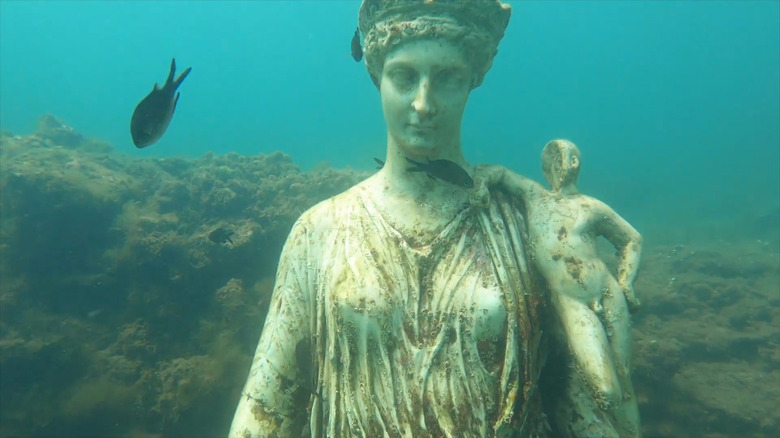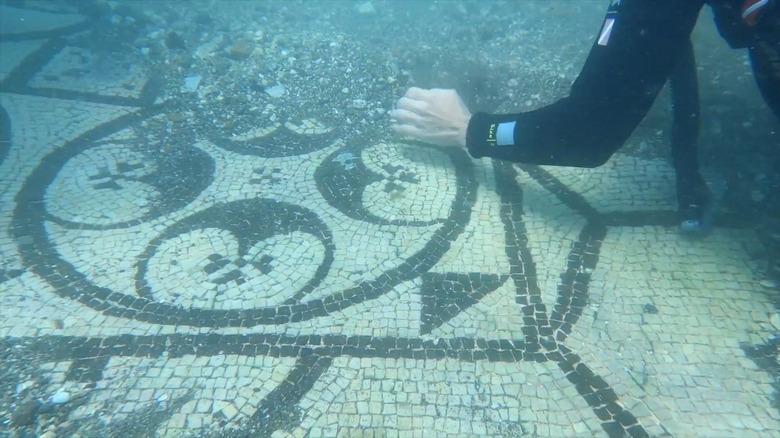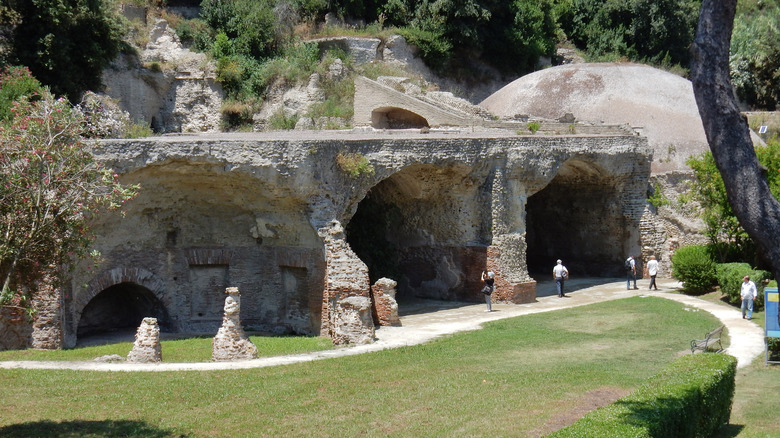Sink Down To One Of Few Underwater Parks In The World In This Little-Known Area Of Italy
If you're visiting Naples, Italy, you have a lot to explore, from beautiful palaces to restaurants you won't want to leave. It's also a great home base to learn more about the ancient world. Naples sits about 17 miles west of the must-see destroyed and preserved city of Pompeii (which is astonishing, despite sometimes being called a tourist trap). Fifteen miles to the east, however, is an unusual ancient site you've likely never heard of. This spot, sometimes called the "submerged Pompeii," is Baia, which features an underwater archaeological park, one of few in the entire world.
Once a holiday resort town for the wealthy and powerful of ancient Rome, beginning in the first century B.C.E., it partially sunk under the sea due to bradyseism, a phenomenon in which volcanic activity causes the earth's crust to rise and fall. Luminaries of the ancient world like Julius Caesar, Mark Antony, Cicero, and Emperors Claudius and Nero had villas there, and the remains of some of them, including incredible mosaics, can still be seen under the water.
While some of the statues have been removed to preserve them, replicas have been placed in the same spot. (You can see the originals in the nearby Baia Museum.) You can experience it all while snorkeling, or scuba diving, and there are several places that will take you on an underwater dive or snorkeling trip, like Centro Sub Campi Flegrei. (Their snorkel trips include gear, which travel pro Rick Steves says you shouldn't bother packing anyway.) You can also take a diving tour in a glass-bottomed boat from Freedome. The artifacts are between 16.4- and a bit under 43-feet down, so they're not hard to spot.
Exploring the underwater city of Baia
The artifacts are plentiful in this underwater park, which was opened in 2002. One site is the Nymphaeum (an artificial cave with statues) of Emperor Claudius, where you can see replica statues. Nero's villa is there as well (and it was identified because of a water pipe with his name on it, as well as from the writings of the historian Tacitus). Some of the underwater mosaics are gorgeous, and incredibly preserved as you can see above. Beginners should obviously go over the basics before diving here, but it's well worth the effort.
One you must check out is the geometric black and white mosaic in the remains of the Villa a Protiro, though you may have to swish some sand away to do so. There are the remains of bath houses and temples, as well as a paved road. You can even see a spot called the Secca delle Furmose, where there are bubbles coming up from the sand. (This town was known in antiquity for its hot springs.) It's interesting to note that Baia wasn't destroyed by a volcanic eruption the way Pompeii was. People began to leave when it started to sink below the surface little by little.
One reviewer on Reddit said of the experience, "It was the easiest dive I've ever done. 2 dives, super shallow (max depth 17ft), there's a snorkeling option but it's nice to just be able to stay under, it's like a 5min boat ride from the shop. If you only have your OW [open water diving certification] that should suffice. I'm almost certain you can even do a discovery dive if you're not certified. We went with Centro sub Campi Flegrei and it was all smooth sailing." On the nearby beach, you'll find showers, a bar, changing rooms, and spots to enjoy the sun when you're finished.
Checking out the archaeological park on land and the Baia Museum
Outside of the water, make sure to visit the Archaeological Park of the Terme di Baia. There you'll find several residences, including living quarters, bedrooms, and porticos, spread over several terraced levels. You'll see the Roman baths and the Temple of Mercury, which is a domed building in the lower area, as well as the site of a traditional villa garden, cisterns to collect rainwater, and lovely arches. There is the Temple of Venus as well, which is an octagonal building that housed a pool.
One reviewer on TripAdvisor said that this is a site frequented by fewer tourists than you may expect. "The archaeological site has superb views, and whilst not on the same level of preservation as Pompeii, still has some fabulous mosaics and buildings over several terraced levels, mainly a large bath complex," they wrote. "Even now in early summer there were only a couple of other people wandering around – so peaceful and atmospheric. The temple of Mercury was unfortunately closed when we visited, but that didn't detract from our time spent there. Be aware there are a lot of steps, not huge amounts of information (but enough if you take time to read), and look out for the upside down tree!"
You should also visit the Archaeological Museum of the Phlegraean Fields inside the Baia Castle. There you'lla find a reconstruction of the Nymphaeum of Emperor Claudius, which you saw underwater. There are also statues of god and goddesses, Emperors like Vespasian and Titus, and Roman era plaster casts.


